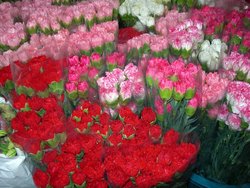Carnation
|
|
| Carnation | ||||||||||||||
|---|---|---|---|---|---|---|---|---|---|---|---|---|---|---|
 Carnation in flower | ||||||||||||||
| Scientific classification | ||||||||||||||
|
The Carnation (Dianthus caryophyllus) is a flowering plant native to the Near East and has been cultivated for the last 2,000 years. Its original natural flower color was pinkish-hued (flesh-like or "carnal", hence the name "carnation"), but later, cultivars of other colors, including red, white, yellow and greenish, have been developed.
Although originally applied to the species Dianthus caryophyllus, the name Carnation is also often applied to some of the other species of Dianthus, and more particularly to garden hybrids between D. caryophyllus and other species in the genus.
Some scholars believe that the name "carnation" comes from "coronation" or "corone" (flower garlands), as it was one of the flowers used in Greek ceremonial crowns. Others think the name stems from the Greek carnis (flesh), which refers to the original color of the flower, or incarnacyon (incarnation), which refers to the incarnation of God made flesh.
Sentiment and symbolism
Carnations are often worn on special occasions, especially Mother's Day and weddings. They were known as "Jove's Flower" in ancient Rome as a tribute to one of their beloved gods. In Korea, a young girl places three carnations in her hair to tell her fortune. If the top flower dies first, her last years of life will be difficult; if it is the middle flower, her earlier years will bring the most grief. Worst of all, if the bottom flower dies first, the poor girl will be miserable her whole life.
The carnation is also the symbol of the Portuguese Carnation Revolution.
For the most part, carnations express love, fascination, and distinction. Light red carnations represent admiration, while dark red denote deep love and affection. White carnations indicate pure love and good luck; striped symbolize a regret that a love cannot be shared. Green carnations are for St. Patrick's Day; purple carnations indicate capriciousness. Pink carnations have the most symbolic and historical significance. According to Christian legend, carnations first appeared on Earth as Jesus carried the Cross. The Virgin Mary shed tears at Jesus' plight, and carnations sprang up from where her tears fell. The pink carnation became the symbol of a mother's undying love, and in 1907 was chosen by Ann Jarvis as the emblem of Mother's Day, now observed in the United States and Canada on the second Sunday in May.



